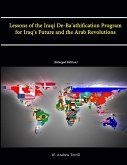The Arab Spring is an event that has radically shifted the geopolitical landscape in one of the most volatile regions of the world. Many experts and policy makers were caught off guard by the speed and organizational ability of disparate citizens that orchestrated and executed these revolutions. As the dust settles and the United States begins to reassess the new environment, this monograph asserts that certain indicators can assist planners in predicting both the nature of potential revolutions and the likelihood of stability following revolutions in North Africa and the Middle East. The purpose of this monograph is to analyze which variables played a significant role in the nature of the Arab Spring revolutions. This study hypothesizes that the civil-military relationship in the affected countries is that primary variable. This monograph uses the case study method by analyzing civil-military relationships, economics, and political pluralism in Tunisia, Egypt and Libya. In conclusion, the constant indicator for less violent revolutions, as well as the attainment of revolutionary goals, was a universally accepted civil-military relationship. The findings of this monograph support the hypothesis of the primary impact that the civil-military relationships had in the affected countries. Each of the countries had disparate economic conditions as well as vastly different levels of political pluralism amongst their populations. These findings do not support a uniform grievance of the people, be economic or in the form of civil society enfranchisement and these variables offer little in future analysis of potential problem areas for military planners. However, the data clearly demonstrated that the civil-military relationship amongst the elites, the military, and the population was a reliable indicator as to the nature and violence level that would be characteristic of each revolution. This monograph also provides a framework for planners to approach potentially unstable








